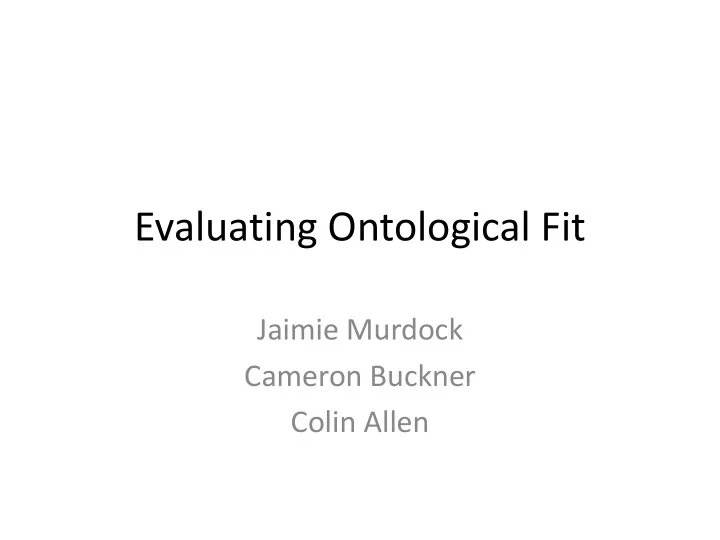

Evaluating Ontological Fit Jaimie Murdock Cameron Buckner Colin Allen
The Representation Problem • What is the best way to encode data? – Depends on the data – Depends on the purpose – Fields • Data structures • Visualization • Statistics • How do we measure a representation’s fitness? – Reflects the underlying data – Stable across iterations – Useful for the end user • No “Golden Standard” for many domains
Outline • The Representation Problem • Digital Humanities – The Stanford Encyclopedia of Philosophy (SEP) – The Indiana Philosophy Ontology Project (InPhO) • The process – 1. Data Mining – 2. Expert Feedback – 3. Machine Reasoning • Evaluating Ontological Fit – The violation score – The volatility score – Improving InPhO
The Representation Problem DIGITAL HUMANITIES
Stanford Encyclopedia of Philosophy Leading digital reference work 13.5 million words ~1200 articles 700,000 weekly hits http://plato.stanford.edu
The Indiana Philosophy Ontology Project Pragmatic attempt to organize the discipline of philosophy through machine learning, augmented by expert verification ~2,200 concepts ~5,000 concept evaluations ~1,750 thinkers ~15,000 thinker evaluations ~1,100 journals http://inpho.cogs.indiana.edu
InPhO Goals • Ontology – formal representation of concepts in a domain and the relationship between those concepts • Provide useful tools – Cross-referencing – Semantic search – Document classification – Visualizations • “Guided serendipity”
InPhO Process
1. Data Mining • Uses natural language processing (NLP) techniques to generate co- occurrence graph of all concepts in the SEP • Two statistical measures for each graph edge: – Semantic similarity – Relative generality (Shannon entropy) • 1.6 million graph edges • Further details in Niepert 2007
2. Expert Verification • Present hypothetical relations to users. • Users stratified by domain expertise • Further details: Allen 2008, Niepert 2009, Buckner 2010
3. Machine Reasoning • Input: Verification combined Sample Rules: with statistical data More-specific(X,Y) :- more- general(Y,X) • Answer set programming Possible-instance(X,Y) :- • Output: Populated ontology highly-related(X,Y), more- specific(X,Y), class(Y), not with taxonomic projection class(X). • Further details: Niepert 2008 Inconsistent(X,Y) :- more- specific(X,Y), more- general(X,Y)
3. Machine Reasoning
API and Tools • Practical usage of data • Cross-reference engine – Captures ~75% of hand- picked references • Semantic navigation – Taxonomy browser • Online API using the RESTful Web Services paradigm – Leverages HTTP protocol – Allows SEP integration – Use by Noesis domain- specific search
Visualizations
The Representation Problem Digital Humanities EVALUATING ONTOLOGICAL FIT
The Representation Problem Revisited • Fitness measures: – Reflects the underlying data (the SEP) – Stable across iterations (consistent taxonomic structure) – Useful for the end user (promotes serendipity) • No golden standard for philosophy • Better representation will be more useful
Evaluating Ontological Fit Violation Score Volatility Score • Between-methods • Within-method over time • Data fitness measure • Stability measure
The Violation Score • Compares each ruleset’s fitness to the corpus • Only compares the same input • Iterates over each is-a relation to see if it violates a statistical hypothesis. – S-violation: actual distance – predicted distance – E-violation: actual depth – predicted depth • Simple average of two measures:
Examining Volatility • Each instance is declared as is-a(X,Y) . – Shows movements is-a(X,Y)=>is-a(X,Z) and unique is-a(X,Y) for each output set – Already useful in showing incremental improvements across iterations • is- a(Hilbert’s program, phil. of science) => is- a( ‘’ , phil. of mathematics) – Experts show higher violation, but qualitative examination shows greater reflection of philosophical structure • Is-a(symbolic processing, phil. of computer science) • Is-a(mental state, phil. of mind)
The Volatility Score • Measures change in assertion or non- assertion of is-a(X,Y) over time. • Heat map visualization – The more red, the less stability. – Also useful for showing areas of controversy
Improving InPhO Conflicting Feedback Dangling Links • Evidence to support a link(X,Y), • Users will disagree but not enough to support – Naïve method ins(Y). • the expert wins – Ex) cognitive science, phil. of mind, folk psychology, artificial – New methods intelligence, phil of computer • preprocessing conflicts science => symbolic processing through weighted voting • Result of design decisions: • each evaluation is a fact in – more-specific(X,Z) :- more-specific(X,Y), the answer set more-specific(Y,Z) • Weighted Transitivity (computationally intensive) – more-specific(X,Z,min(A,B)) :- more-specific(X,Y,A), more-specific(Y,Z,B)
Improving InPhO Name violation sviolation eviolation ins pairs eval comparisons viol/ins Current Rules 0.684009 0.369258 0.314751 868 462787 12442819 0.000788 Current w/voting 0.685254 0.369813 0.315441 878 467787 12729500 0.00078 Transitivity 0.684908 0.371583 0.313325 976 508687 15597573 0.000702 Transitivity w/voting 0.686428 0.372278 0.31415 999 519162 16262791 0.000687
Recap • The Representation Problem • Digital Humanities – The Stanford Encyclopedia of Philosophy (SEP) – The Indiana Philosophy Ontology Project (InPhO) • The process – 1. Data Mining – 2. Expert Feedback – 3. Machine Reasoning • Evaluating Ontological Fit – The violation score – The volatility score – Improving InPhO
The Representation Problem Digital Humanities Evaluating Ontological Fit QUESTIONS?
Recommend
More recommend